The automotive market is buzzing with competition, especially when it comes to SUVs, which have become the go-to choice for families and adventure-seekers alike. In this comparison, we will take a closer look at two striking models: the Hyundai Tucson and the Renault Symbioz. Both vehicles promise innovation, efficiency, and comfort, but how do they stack up in terms of performance, technology, and overall value?
Hyundai Tucson vs Renault Symbioz – Which model is better for everyday use?
Both models have their strengths – but which one suits you more?
Compare performance, efficiency, price and space directly: Hyundai Tucson or Renault Symbioz?
Design and Comfort
When it comes to aesthetics and comfort, the Hyundai Tucson stands out with a broader and bolder stance. Measuring at 4510 mm in length and 1865 mm in width, it exudes robust confidence on the road. With a height of 1650 mm, the Tucson offers ample headroom and a spacious trunk capacity of 546 to 620 liters, making it an ideal choice for those with active lifestyles.
The Renault Symbioz, on the other hand, takes a more refined approach to design. Slightly smaller at 4413 mm in length and 1797 mm wide, it is still spacious enough for five passengers. Its height of 1575 mm and trunk capacity of 492 liters provide adequate room for everyday needs, although it lags behind the Tucson in sheer volume.
Technical Specifications and Engine Performance
Under the hood, the Hyundai Tucson offers an impressive array of engine configurations, including a full hybrid option with a robust power range from 136 to 252 HP, depending on the variant. The Tucson's diesel MHEV and petrol engines promise flexibility, alongside varying torque output ranging from 265 to 367 Nm. With different powertrains available, Tucson also provides choices between front-wheel and all-wheel drive. Acceleration from 0-100 km/h varies with engine choice but can be as quick as 7.9 seconds, showcasing its sporty capabilities.
In comparison, the Renault Symbioz offers a single full hybrid powertrain option that produces a modest 143 HP with 250 Nm of torque. The Symbioz can reach 0-100 km/h in 10.6 seconds, which, while competitive, does not quite match the Tucson's agility. The integrated battery capacity of 0.6 kWh marks a step towards electrification, making the vehicle more energy-efficient with a consumption rate of 4.8L/100km, which is commendable for urban driving.
Innovation and Technology
The Hyundai Tucson is replete with technological innovations, including advanced driver-assistance systems (ADAS) for enhanced safety and convenience. Features like adaptive cruise control, lane-keeping assist, and a high-resolution infotainment system cater to tech-savvy customers. The availability of a plug-in hybrid variant adds to its eco-friendly credentials, showcasing Hyundai's commitment to sustainability.
The Renault Symbioz symbolizes Renault's vision of future mobility with strong connectivity features and automated driving—attributes that appeal to the eco-conscious consumer. The hybrid technology ensures lower emissions, registering a CO2 output of just 109 g/km, and highlights the brand's focus on reducing its carbon footprint. However, it doesn't offer as much versatility in terms of powertrain options compared to the Tucson.
Fuel Efficiency and Environmental Impact
Fuel efficiency is a critical aspect for many buyers, and here both vehicles have their strengths. The Tucson has varied options with the most efficient diesel variant reaching a consumption of 5.1L/100km, while its plugin hybrid version can operate in electric mode for up to 70 km, thus catering to short urban commutes without utilizing fossil fuels.
In contrast, the Renault Symbioz shines with a lower fuel consumption figure of 4.8L/100km, boasting one of the lowest CO2 efficiency classifications at "C." This makes it an attractive option for environmentally conscious drivers, although its electric range cannot match the hybrid capabilities of the Tucson.
Conclusion: Which SUV Reigns Supreme?
In conclusion, both the Hyundai Tucson and the Renault Symbioz cater to different kinds of customers. The Tucson acts as a versatile SUV with a broader range of performance, various configurations, and enhanced technology. It’s well suited for those who crave adaptability, power, and advanced features.
On the other hand, the Symbioz appeals primarily to eco-conscious consumers looking for a hybrid experience with smart technology and innovation, offering a glimpse into the future of sustainable mobility. Ultimately, the choice will depend on personal preference and priorities, whether one values performance and versatility over hybrid efficiency and technology.
Here’s where it gets real: The technical differences in detail
Costs and Efficiency:
Price and efficiency are often the first things buyers look at. Here it becomes clear which model has the long-term edge – whether at the pump, the plug, or in purchase price.
Renault Symbioz has a distinct advantage in terms of price – it starts at 24400 £, while the Hyundai Tucson costs 30600 £. That’s a price difference of around 6206 £.
Fuel consumption also shows a difference: Hyundai Tucson manages with 1 L and is therefore significantly more efficient than the Renault Symbioz with 4.50 L. The difference is about 3.50 L per 100 km.
Engine and Performance:
Power, torque and acceleration say a lot about how a car feels on the road. This is where you see which model delivers more driving dynamics.
When it comes to engine power, the Hyundai Tucson has a clearly perceptible edge – offering 252 HP compared to 158 HP. That’s roughly 94 HP more horsepower.
In acceleration from 0 to 100 km/h, the Hyundai Tucson is somewhat quicker – completing the sprint in 7.90 s, while the Renault Symbioz takes 9.10 s. That’s about 1.20 s faster.
In terms of top speed, the Hyundai Tucson performs a bit better – reaching 204 km/h, while the Renault Symbioz tops out at 180 km/h. The difference is around 24 km/h.
There’s also a difference in torque: Hyundai Tucson pulls distinct stronger with 379 Nm compared to 265 Nm. That’s about 114 Nm difference.
Space and Everyday Use:
Whether family car or daily driver – which one offers more room, flexibility and comfort?
Both vehicles offer seating for 5 people.
In curb weight, Renault Symbioz is somewhat lighter – 1359 kg compared to 1542 kg. The difference is around 183 kg.
In terms of boot space, the Hyundai Tucson offers barely noticeable more room – 620 L compared to 576 L. That’s a difference of about 44 L.
In maximum load capacity, the Hyundai Tucson performs hardly perceptible better – up to 1799 L, which is about 117 L more than the Renault Symbioz.
When it comes to payload, Hyundai Tucson to a small extent takes the win – 545 kg compared to 459 kg. That’s a difference of about 86 kg.
Who comes out on top?
Overall, the Hyundai Tucson shows itself to be leaves the rival little chance and secures the title of DriveDuel Champion.
It convinces with the more balanced overall package and proves to be the more versatile choice for everyday use.
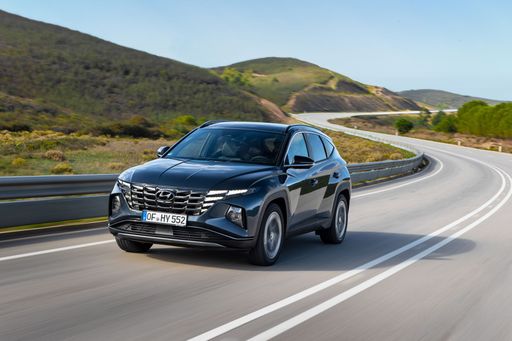 @ Hyundai Motor Company
@ Hyundai Motor Company
Hyundai Tucson
Hyundai Tucson
Hyundai Tucson marries bold, sculpted looks with a clever, roomy cabin that feels smarter than its price tag suggests. It's composed on the road, easy to live with day-to-day, and a sensible choice for buyers who want SUV style without the showroom theatrics.
details @ Hyundai Motor Company
@ Hyundai Motor Company
 @ Hyundai Motor Company
@ Hyundai Motor Company
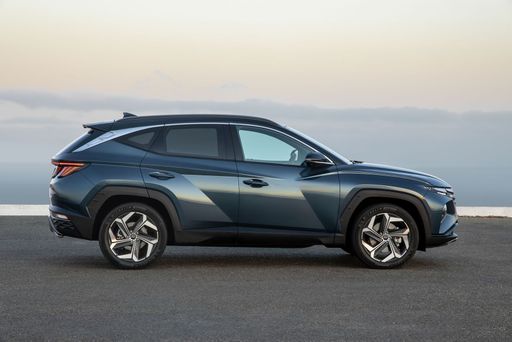 @ Hyundai Motor Company
@ Hyundai Motor Company
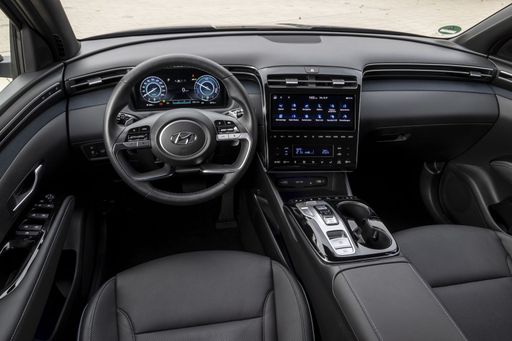 @ Hyundai Motor Company
@ Hyundai Motor Company
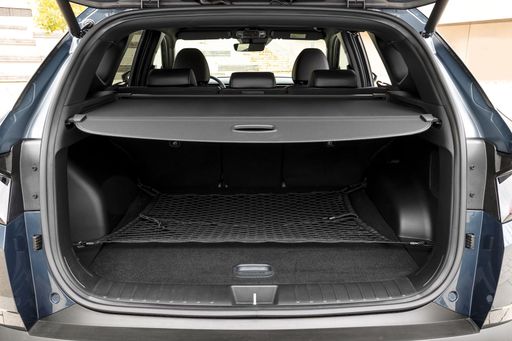 @ Hyundai Motor Company
@ Hyundai Motor Company
Renault Symbioz
The Renault Symbioz feels less like a traditional car and more like a rolling living room that's been told it's allowed to drive — its flowing lines and minimalist cabin are pure concept-car theatre that teases the future of everyday transport. For buyers with an eye for design and a taste for tech-forward ideas, the Symbioz is an alluring vision of what Renault could offer tomorrow, even if it's not yet a model you can park in your driveway.
details @ Renault Group Media
@ Renault Group Media
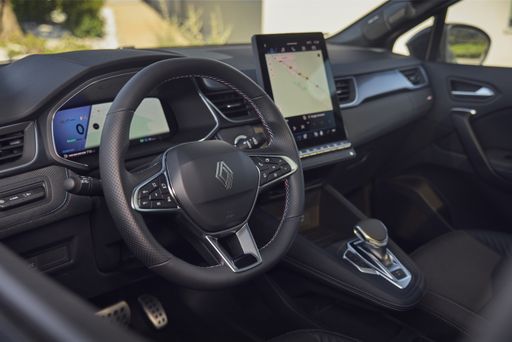 @ Renault Group Media
@ Renault Group Media
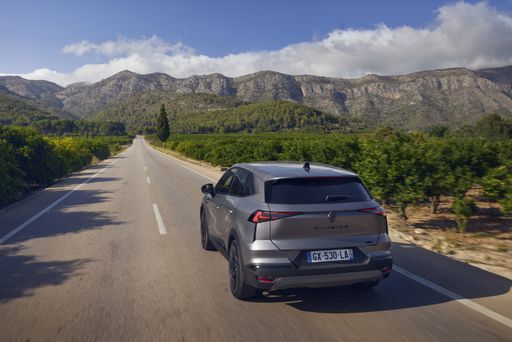 @ Renault Group Media
@ Renault Group Media
 @ Hyundai Motor Company
@ Hyundai Motor Company
|
 @ Renault Group Media
@ Renault Group Media
|
|
|
|
Costs and Consumption |
|
|---|---|
|
Price
30600 - 46300 £
|
Price
24400 - 30700 £
|
|
Consumption L/100km
1 - 7.6 L
|
Consumption L/100km
4.5 - 6 L
|
|
Consumption kWh/100km
-
|
Consumption kWh/100km
-
|
|
Electric Range
64 - 70 km
|
Electric Range
-
|
|
Battery Capacity
-
|
Battery Capacity
-
|
|
co2
22 - 172 g/km
|
co2
102 - 136 g/km
|
|
Fuel tank capacity
42 - 54 L
|
Fuel tank capacity
48 L
|
Dimensions and Body |
|
|---|---|
|
Body Type
SUV
|
Body Type
SUV
|
|
Seats
5
|
Seats
5
|
|
Doors
5
|
Doors
5
|
|
Curb weight
1542 - 1889 kg
|
Curb weight
1359 - 1544 kg
|
|
Trunk capacity
546 - 620 L
|
Trunk capacity
492 - 576 L
|
|
Length
4510 - 4535 mm
|
Length
4413 mm
|
|
Width
1865 mm
|
Width
1797 mm
|
|
Height
1650 mm
|
Height
1575 mm
|
|
Max trunk capacity
1721 - 1799 L
|
Max trunk capacity
1582 - 1682 L
|
|
Payload
523 - 545 kg
|
Payload
376 - 459 kg
|
Engine and Performance |
|
|---|---|
|
Engine Type
Diesel MHEV, Plugin Hybrid, Petrol, Full Hybrid
|
Engine Type
Full Hybrid, Petrol MHEV
|
|
Transmission
Automatic, Manuel
|
Transmission
Automatic, Manuel
|
|
Transmission Detail
Dual-Clutch Automatic, Automatic Gearbox, Manual Gearbox
|
Transmission Detail
Automatic Gearbox, Manual Gearbox, Dual-Clutch Automatic
|
|
Drive Type
Front-Wheel Drive, All-Wheel Drive
|
Drive Type
Front-Wheel Drive
|
|
Power HP
136 - 252 HP
|
Power HP
140 - 158 HP
|
|
Acceleration 0-100km/h
7.9 - 11.6 s
|
Acceleration 0-100km/h
9.1 - 11 s
|
|
Max Speed
180 - 204 km/h
|
Max Speed
180 km/h
|
|
Torque
250 - 379 Nm
|
Torque
250 - 265 Nm
|
|
Number of Cylinders
4
|
Number of Cylinders
4
|
|
Power kW
100 - 185 kW
|
Power kW
103 - 116 kW
|
|
Engine capacity
1598 cm3
|
Engine capacity
1332 - 1789 cm3
|
General |
|
|---|---|
|
Model Year
2024 - 2025
|
Model Year
2025
|
|
CO2 Efficiency Class
E, B, F, D
|
CO2 Efficiency Class
C, D, E
|
|
Brand
Hyundai
|
Brand
Renault
|
What drive types are available for the Hyundai Tucson?
Available configurations include Front-Wheel Drive or All-Wheel Drive.
The prices and data displayed are estimates based on German list prices and may vary by country. This information is not legally binding.
